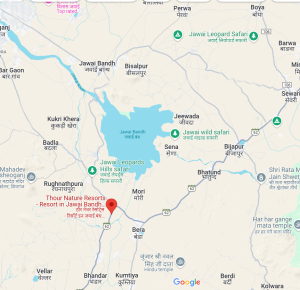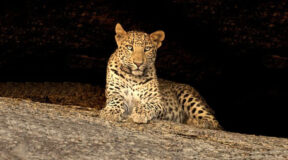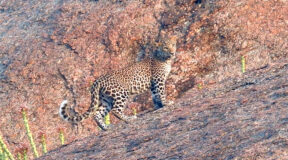Located in the heart of Rajasthan, India, lies a wildlife sanctuary unlike any other — Jawai Bandh. Well-known for its breathtaking landscapes and diverse flora and fauna, Jawai grabs the attention of adventurers and nature enthusiasts who want to immerse themselves in its beauty.
From the majestic Aravalli Hills to its vibrant population of leopards and other animals, every corner of this place offers a unique glimpse into the stunning beauty of nature. If you’re planning a thrilling leopard safari to witness these majestic cats in this region, Jawai Bandh promises a memorable experience.
If you are planning a short trip to Jawai this weekend and want to make the most of your visit to this mesmerizing sanctuary, here’s a guide to help you get started.
Let’s have a look!
Is it Actually a Jawai National Park?
While many people refer to this place as Jawai National Park, it is a Jawai leopard conservation reserve dedicated to preserving and protecting these majestic cats and their natural habitat.
It is spread over an area of 50 kilometres, and this reserve operates independently without government involvement. Local rangers conduct leopard and jungle safaris in the region, guiding visitors through nearby hills and villages to observe the wildlife in its natural setting.
History of Jawai Leopard Conservation Reserve
Located in the Pali district of Rajasthan, Jawai got its name from the Jawai Dam, which was created in the 1950s and is a significant water source for the region. The dam not only transformed the landscape but also turned the surrounding area into a thriving habitat for a wide range of wildlife, especially leopards.

Unlike other sanctuaries or reserves, leopards in Jawai live freely among human settlements, a coexistence that dates back several generations. What makes Jawai special is the harmony between leopards and the Rabari community. It is a semi-nomadic pastoral tribe that is known for its deep respect for nature. The Rabaris have lived in Jawai for centuries and herd cattle and goats across the rocky terrain.
The Rabari people spiritually consider leopards as sacred creatures and take them as guardians rather than threats. This has allowed leopards to flourish without the fear of persecution, which has made Jawai one of the few places in Jawai where they roam freely and peacefully near human settlements.
Over the years, Jawai Bandh has started attracting wildlife enthusiasts, conservationists, and travellers from around the world. What once was a rural region gradually evolved into a destination people loved to visit. Today, Jawai is not only known for its stunning granite hills and scenic beauty but also for its flourishing population of wildlife.
Wildlife of Jawai: More Than Just Leopards
While Jawai is known for its thriving leopard population, its wildlife diversity goes far beyond that. Located between the granite hills and the Jawai Dam, this region supports a wide range of species that make every safari a thrilling experience.
People who love watching birds will be left delighted by the sight of flamingos, cranes, pelicans, and over a hundred migratory and resident bird species. Jawai Bandh is a birding paradise, especially during the winter when the reservoir becomes a haven for migratory birds.
Apart from leopards and birds, Jawai is home to several other animals, such as hyenas, jackals, jungle cats, and Indian foxes that roam around the rocky terrain. The area is also known for crocodile spotting; they bask along the banks of the dam, as well as herds of nilgai, langurs, and several reptiles.
The Landscape and Habitat of Jawai
What makes Jawai Bandh truly exceptional is not just its wildlife but also its rugged and raw terrain. Huge granite hills dotted with natural caves offer shelter for leopards, while the open scrub forests and grasslands provide food for herbivores of the region.
The Jawai Dam adds to the region’s ecological diversity, which attracts a wide range of birds and sustains aquatic life. This mix of rocky terrain, water bodies, and semi-arid vegetation creates a unique habitat for predators and prey.
Best Time to Visit Jawai
The best time to experience the wild side of Jawai is between October and March. That’s because the weather is pleasant, and wildlife sightings are at their peak. During these months, the leopards are more active and easier to spot around the granite hills. Other than this, the temperatures are mild, and the clear skies make it the perfect time for safaris. Migratory birds also flock to the region, which makes it the best time to visit Jawai Bandh.
Jawai vs Other Wildlife Sanctuaries in Rajasthan
While Jawai offers a unique wildlife experience you can’t miss, but one of the questions is how it compares to other wildlife sanctuaries in Rajasthan. Let’s take a closer look!
| Jawai Bandh | Ranthambore National Park | Sariska Tiger Reserve | Desert National Park (Jaisalmer) | |
| Main Attraction | The main attraction of Jawai Bandh is the opportunity to spot leopards. | Ranthambore National Park is primarily known for its tigers. | The main attraction of Sariska Tiger Reserve is the tigers, along with its dense dry forests. | Desert National Park is known for its Great Indian Bustard and other desert wildlife. |
| Human-Wildlife Coexistence | There is strong human-wildlife coexistence at Jawai, with leopards often found near villages. | In Ranthambore, human settlements are restricted. | In Sariska, human-wildlife coexistence is low. | Human-wildlife coexistence in Desert National Park is moderate, with pastoral communities living nearby. |
| Tourist Footfall | Jawai sees a medium number of visitors. | Ranthambore attracts a high volume of tourists, which makes it crowded. | Sariska experiences a medium level of tourist footfall. | Desert National Park has a low number of visitors. |
| Best For | Jawai is best for those seeking close leopard sightings and an offbeat travel experience. | Ranthambore is ideal for tiger safaris. | Sariska is perfect for those looking to see tigers in a crowded setting. | Desert National Park is best for birdwatching. |
Top Things to Do Around Jawai
Here are some of the top things that you can enjoy doing around the Jawai for a thrilling and adventurous trip:
- Leopard Safari
The best part of visiting Jawai is the opportunity to go on a leopard safari. The rocky terrain and caves in the region are home to a huge population of leopards, and guided tours offer an up-close experience of these majestic cats.
- Visit Jawai Dam
The Jawai Dam is one of the best places for birdwatching, especially during the winter months. Migratory birds such as flamingos, cranes, and other waterfowl flock to the dam, which makes it a prime location for bird lovers. Also, you can spot crocodiles there!
- Explore Local Villages
Visit the nearby villages to experience the traditional rural lifestyle of the region. You can learn about the local Rabari community, who live in harmony with the wildlife. While returning, you can also shop for local handicrafts.
- Photography
The unique combination of wildlife, rocky hills, and scenic views makes Jawai an ideal location for photography. There, you can capture the stunning views of the sunsets and sunrises. Also, leopards, birds, and the rich landscape provide several opportunities for photographers to click stunning pictures.
- Visit the Ancient Temples
You can even explore the ancient temples in the region, such as the one near the Jawai village. These temples offer a glimpse into the region’s spiritual and architectural heritage.
Wrapping Up
Indeed, the Jawai Bandh safari is the best experience for wildlife enthusiasts and adventurers. It offers a rare glimpse into the world of leopards and other wildlife creatures.
For those willing to visit Jawai to experience wilderness, Thour Nature Resorts emerges as the best resort in Jawai. With its blend of comfort, hospitality, and proximity to the key safari areas, our resort stands out for exploring this region.
So, plan out a short trip to Jawai to experience the region’s wilderness and culture!









